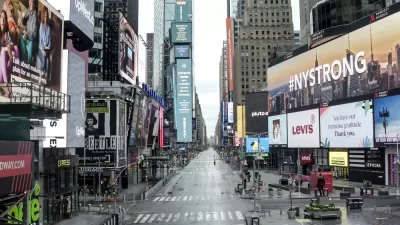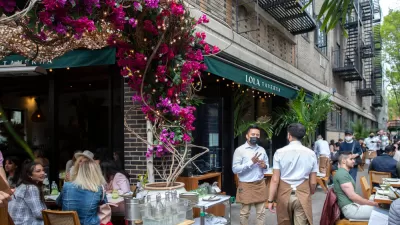Cities could learn from the grocery store chain's successful navigation of the uncertainty of the COVID-19 pandemic.

The pandemic has thrown the benefits of urban density into doubt as recently untethered work-from-home employees flee city centers, driven by fear of COVID-19, lack of the usual draws like nightclubs and restaurants, and lower costs of living elsewhere. As people hunker down at home and grocery stores become major sites of outbreaks, one grocery chain has managed to implement low-cost but wildly effective measures to keep its employees safe and its sales at pre-pandemic levels. According to Nate Cherry, Trader Joe's has managed to "incentivize the right, community-oriented behaviors" using "functional problem-solving, practical solutions, better data mining and analysis, and more flexibility" that have helped the popular chain thrive during the pandemic.
Trader Joe's,with an employee infection rate of 2.4% (far below the 20% averaged by other grocery stores) has implemented small but powerful changes that offer valuable lessons for cities. As a hyper-local amenity, their stores mainly serve users that live within on or two miles, reducing customers' reliance on transportation for basic necessities—a worthy goal for neighborhoods and a cornerstone of the recent "15-minute city" movement. The store also provides an excellent example of space management in their parking lots. "Similarly, one of the easiest things we can do as planners is to more intelligently manage the infrastructure we have — specifically, sidewalks, which can be better structured to accommodate passive and active areas, as well as seating and landscape areas." Other tools that would be useful anywhere include sanitation infrastructure(in the case of Trader Joe's, visible hand-washing stations), attention to proper ventilation, and a flexibility to implement temporary solutions quickly and cost-effectively.
Planners must look for the opportunities and tweaks that will allow us to resume urban life with all the things we love about it more safely and equitably. "Our cities of tomorrow might be much like the ones of today, just a bit less crowded, with access to more resources and managed with greater responsiveness — like your favorite grocery store."
FULL STORY: 5 lessons Trader Joe’s can teach the city of the future

Alabama: Trump Terminates Settlements for Black Communities Harmed By Raw Sewage
Trump deemed the landmark civil rights agreement “illegal DEI and environmental justice policy.”

Study: Maui’s Plan to Convert Vacation Rentals to Long-Term Housing Could Cause Nearly $1 Billion Economic Loss
The plan would reduce visitor accommodation by 25% resulting in 1,900 jobs lost.

Why Should We Subsidize Public Transportation?
Many public transit agencies face financial stress due to rising costs, declining fare revenue, and declining subsidies. Transit advocates must provide a strong business case for increasing public transit funding.

Paris Bike Boom Leads to Steep Drop in Air Pollution
The French city’s air quality has improved dramatically in the past 20 years, coinciding with a growth in cycling.

Why Housing Costs More to Build in California Than in Texas
Hard costs like labor and materials combined with ‘soft’ costs such as permitting make building in the San Francisco Bay Area almost three times as costly as in Texas cities.

San Diego County Sees a Rise in Urban Coyotes
San Diego County experiences a rise in urban coyotes, as sightings become prevalent throughout its urban neighbourhoods and surrounding areas.
Urban Design for Planners 1: Software Tools
This six-course series explores essential urban design concepts using open source software and equips planners with the tools they need to participate fully in the urban design process.
Planning for Universal Design
Learn the tools for implementing Universal Design in planning regulations.
Smith Gee Studio
Alamo Area Metropolitan Planning Organization
City of Santa Clarita
Institute for Housing and Urban Development Studies (IHS)
City of Grandview
Harvard GSD Executive Education
Toledo-Lucas County Plan Commissions
Salt Lake City
NYU Wagner Graduate School of Public Service





























